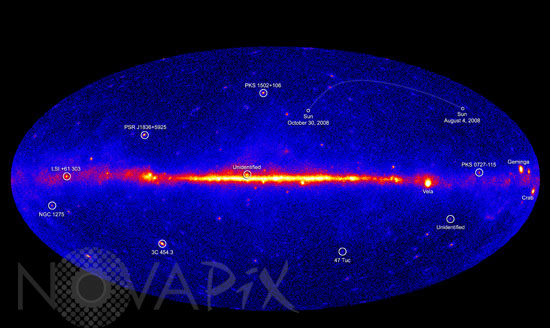Photo Agency - Astronomy - Space - Nature

The Gamma ray sky
author: Nasa/DOE/Novapix
reference: a-vlc12-00004
Image Size 300 DPI: 29 * 17 cm
All-sky image seen in gamma ray showing the glowing gas of the Milky Way, blinking pulsars, and galaxies billions of light-years away. The all-sky image released today shows us how the cosmos would look if our eyes could detect radiation 150 million times more energetic than visible light. The view merges Large Area Telescope (LAT) on Fermi Gamma-ray Space Telescope (FGST) observations spanning 87 days, from August 4 to October 30, 2008.
The top five sources within our galaxy are:
The sun. Now near the minimum of its activity cycle, the sun would not be a particularly notable source except for one thing: It's the only one that moves across the sky. The sun's annual motion against the background sky is a reflection of Earth's orbit around the sun.
LSI +61 303. This is a high-mass X-ray binary located 6,500 light-years away in Cassiopeia. This unusual system contains a hot B-type star and a neutron star and produces radio outbursts that recur every 26.5 days. Astronomers cannot yet account for the energy that powers these emissions.
PSR J1836+5925. This is a pulsar -- a type of spinning neutron star that emits beams of radiation -- located in the constellation Draco. It's one of the new breed of pulsars discovered by Fermi that pulse only in gamma rays.
47 Tucanae. Also known as NGC 104, this is a sphere of ancient stars called a globular cluster. It lies 15,000 light-years away in the southern constellation Tucana.
Unidentified. More than 30 of the brightest gamma-ray sources Fermi sees have no obvious counterparts at other wavelengths. This one, designated 0FGL J1813.5-1248, was not seen by previous missions, and Fermi's LAT sees it as variable. The source lies near the plane of the Milky Way in the constellation Serpens Cauda. As a result, it's likely within our galaxy -- but right now, astronomers don't know much more than that.
The top five sources beyond our galaxy are:
NGC 1275. Also known as Perseus A, this galaxy at the heart of the Perseus Galaxy Cluster is known for its intense radio emissions. It lies 233 million light-years away.
3C 454.3. This is a type of active galaxy called a "blazar." Like many active galaxies, a blazar emits oppositely directed jets of particles traveling near the speed of light as matter falls into a central supermassive black hole. For blazars, the galaxy happens to be oriented so that one jet is aimed right at us. Over the time period represented in this image, 3C 454.3 was the brightest blazar in the gamma-ray sky. It flares and fades, but for Fermi it's never out of sight. The galaxy lies 7.2 billion light-years away in the constellation Pegasus.
PKS 1502+106. This blazar is located 10.1 billion light-years away in the constellation Boötes. It appeared suddenly, briefly outshone 3C 454.3, and then faded away.
PKS 0727-115. This object's location in the plane of the Milky Way would lead one to expect that it's a member of our galaxy, but it isn't. Astronomers believe this source is a type of active galaxy called a quasar. It's located 9.6 billion light-years away in the constellation Puppis.
Unidentified. This source, located in the southern constellation Columba, is designated 0FGL J0614.3-3330 and probably lies outside the Milky Way.
FGST has been launched on june 11 2008.
Keywords for this photo:
2008 - 2009 - ASTRONOMY - FALSE COLOR - FERMI GAMMA-RAY SPACE TELESCOPE - FGST - GALAXY - GAMMA - MILKY WAY - NEUTRON STAR - PULSAR - STAR -
Contact : Stéphane Aubin +33-(0)9-51-26-53-76
© Novapix - All rights reserved


